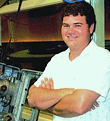|
|
This topic comprises 3 pages: 1 2 3
|
|
Author
|
Topic: Poorly maintained Simplex XL seems to have oil leaks everywhere. Where do I start?
|
|
|
|
|
|
|
|
|
|
|
|
|
Dave Macaulay
Film God

Posts: 2321
From: Toronto, Canada
Registered: Apr 2001
|
 posted 05-13-2008 11:06 PM
posted 05-13-2008 11:06 PM




There are a bunch of places it can leak through... a good cleaning with simple green or some other degreaser will let you see where the oil is actually coming from.
Once the operating side is clean, look for oil running down from behind the upper and lower sprocket mounting subassemblies. These have paper gaskets on old units and rubber "donut" seals on newer ones. If oil is coming from the upper sprocket shaft - dripping off the sprocket (and oiling the film... yuck) then probably the "wick" in the oiling hole in back is missing - this wick reduces the amount of oil getting into the housing so it doesn't fill up and seep through the bushings. If you have problems with the seals/gaskets or this wick thing, be careful as the driving gear mesh for those sprocket shafts is set by positioning the housings when installing them.
If you have oil coming out of the intermittent shaft bushing that's not good. Later models, after Simplex discovered O-rings around 1990, have a tiny one sealing the shaft; earlier production has a spiral groove in the shaft that leads oil back into the intermittent case. You probably shouldn't go inside the intermittent trying to fix a leak there.
A leak from around the intermittent case where it sits in the framing unit leads back to the O-ring revelation. Previous XLs have a system of gutters and drain holes around the intermittent that try to send oil back to the gear side - with reasonable success. Later ones use an O-rings around the intermittent case and another around the framing unit the intermittent fits into. On the old ones goop and gunk block the drain holes and just pulling the intermittent and cleaning them out usually helps a lot. The new ones will need new O-rings if they leak... the drain holes are no longer there. On the whole intermittent/framing collar assemblage just doing a thorough cleaning (the intermittent has to come out for this) can work wonders. Oil seems to follow a wet trail, clean away the trail and it stops.
Out back, Louis and Mark have covered the bases pretty well. The back covers have a tendency to get warped - somebody tries to stop an oil leak by taking the big pliers out and cranking the 3 clamp nuts down. Still leaking? Tighten some more! You may be able to gently bend it back into shape. Be really careful if you have an actual glass window... newer ones are plastic and don't shatter. You shouldn't need a lot of force to seal the back cover! The secret is to have the cover gasket and the sealing surface on the main casting (regardless of type) absolutely clean and oil-free before installing it (note that this is nearly impossible) then carefully tightening the nuts to get slight compression of the seal all the way around.
The drive shaft is probably not sealed at all and you have to keep the oil level such that it's below the hole. There's a paper gasket under the bearing cap that will seep oil if bad, but major leaks here are usually because of misunderstanding the sight glass: the proper sight glass level depends on the projector angle and there should be a small metal sliding ring on the glass tube that is to be set - depending on the tilt angle - to show your full level. The sight glass mounts in front for down tilts, at the rear for up tilts.
The sight glass mounts and hole covers have paper gaskets too.
For oil filling, I assume you don't have the oil filler in the rear cover... Strong also tried an odd approach with a metal sleeve around the shutter timing adjustment knob - this pulls up to cover said knob and is then a filler funnel (no kidding) so if you have this sleeve that pulls up there's your filler. Otherwise use the sight glass filler. You can improve that by improving the hole where it flows into the casting... sight glass, gasket, and casing each have holes the oil has to get through and they rarely line up properly - plus the hole into the casting is often not all the way through leaving a tiny orifice into the oil sump. If you have a pumping oil can that fits tightly into the filler you can force oil through pretty fast too.
| IP: Logged
|
|
|
|
|
|
|
|
|
|
|
|
|
|
Randy Bowden
Expert Film Handler
Posts: 146
From: Portland, OR, USA
Registered: Aug 2000
|
 posted 05-16-2008 03:21 PM
posted 05-16-2008 03:21 PM




Provided your image is stable and the machine is running relatively smooth and quiet, getting the machine up to snuff should not be to terribly difficult. Lets break this down so that it doesn't seem so overwhelming.
Back door: As mentioned previously there is the newer style back door that can be purchased. Or you could just reseal yours. I've resealed numerous old style back doors with good success. Just keep in mind that there are about 4 different variations on the simplex back door. If you have a black XL with matching black door, then you likely have a round tube gasket for the outer seal and a flat black gasket for the window seal. Get the gaskets for the door from Wolk, the outer black gasket that wolk sells is far better than the one you will get from Strong. Also, you may notice that the 3 points on the door where the thumbscrews bolt up have over time become bent forward, thus causing the door to not seal very well. You can flatten them back out with a rubber mallet.
Main Drive: Just get the seal kit and be done with it. This is a major oil leak point without the kit. You will also get new o-rings for the framing shaft with the kit, it's possible you are leaking here as well.
Oil gauge: To reseal the oil gauge you will need the black neoprene gasket, fiber washer and main frame gasket. may as well get a spare sight glass to go along with it, because they do break rather easily.
Feed sprocket assy's usually will not leak unless someone has removed them, then replaced without a new seal. Often on the old XL's the gaskets have more or less glued themselves in place. You are more likely to be leaking oil out the sprocket shaft.
Intermittent: could be leaking oil out the star shaft, case gasket or out of the framing cam area. This one can be a little tricky to figure out, so do all the other stuff first and keep an eye on this area.
| IP: Logged
|
|
|
|
|
|
All times are Central (GMT -6:00)
|
This topic comprises 3 pages: 1 2 3
|
Powered by Infopop Corporation
UBB.classicTM
6.3.1.2
The Film-Tech Forums are designed for various members related to the cinema industry to express their opinions, viewpoints and testimonials on various products, services and events based upon speculation, personal knowledge and factual information through use, therefore all views represented here allow no liability upon the publishers of this web site and the owners of said views assume no liability for any ill will resulting from these postings. The posts made here are for educational as well as entertainment purposes and as such anyone viewing this portion of the website must accept these views as statements of the author of that opinion
and agrees to release the authors from any and all liability.
|

 Home
Home
 Products
Products
 Store
Store
 Forum
Forum
 Warehouse
Warehouse
 Contact Us
Contact Us




 Printer-friendly view of this topic
Printer-friendly view of this topic













![[evil]](graemlins/evil.gif) .
.![[Wink]](wink.gif) !
!


